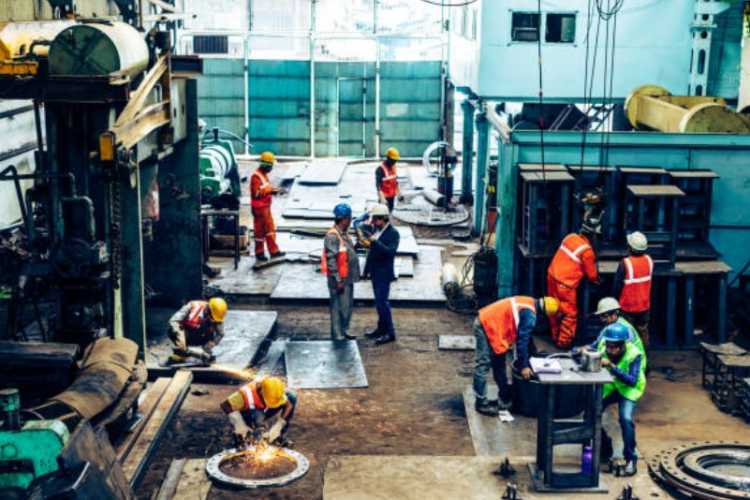
The Indian economy presents a curious paradox. The GDP numbers point to momentum, but the mood in corporate boardrooms tells another story. The first quarter of FY26 delivered a 7.8% growth rate — impressive by any standard. Yet a survey of 14 top executives conducted by a media organisation shows that private investment sentiment remains subdued. Policymakers have long awaited a revival in private capex; the old playbook of tax cuts and subsidies is not enough to coax India Inc into risk-taking.
Gross fixed capital formation — factories, machinery, and infrastructure — contributes nearly 30% to GDP. But private investment as a share of GDP has been on a downward slide since the 2008 global financial crisis, hitting a decadal low of 33% this year, according to ICRA. Despite the government’s efforts — stepped-up infrastructure spending, corporate tax cuts from 30% to 22%, and production-linked subsidies — businesses remain hesitant. Without private capital, sustaining high growth will be difficult.
READ | India bets on MSMEs to power semiconductor mission
The history of rapid development in Asia reveals the centrality of private investment. Japan in the post-war decades, the East Asian tigers through the 1970s and 1980s, and China after 1990 all rode sustained waves of private capital formation. New factories, export-oriented industries, and rising domestic demand created self-reinforcing growth cycles that lifted GDP growth rates above 8% for prolonged periods. Each of these economies combined state-led policy frameworks with private entrepreneurial zeal, generating the kind of long-term momentum that India has so far struggled to replicate.
Weak demand and wage-less growth
The core problem is weak demand. Companies expand only when assured of returns. Post-pandemic India offers no such certainty. Consumption patterns remain uneven: urban demand is soft, wage growth has stalled, and job creation has not kept pace. Even as corporate profits reached a 15-year high in 2025, businesses see little reason to add capacity. Unsold housing inventories in cities are a reminder that the consumer class is not expanding fast enough, while wage-less growth erodes discretionary spending.
External risks compound domestic weaknesses. The global slowdown threatens India’s export prospects, while President Donald Trump’s tariff hikes cast a shadow on trade. Cheap imports from China further depress domestic industry’s appetite for expansion. For many companies, hoarding cash appears safer than building new factories.
Structural shifts in corporate behaviour
Structural changes in Indian capitalism are also at play. Business heirs increasingly behave like asset managers rather than entrepreneurs, preferring financial investments abroad to risky ventures at home. The pandemic reinforced the notion that wealth could be preserved without building anew. The result: fading animal spirits and dampened private capex.
The government must rethink its approach. Singapore’s transparent regulations and low corporate tax regime (17%) have drawn global investment. Vietnam has relied on public investment in infrastructure to crowd in private spending. India could adopt a mix of these strategies: simplify regulations, expand public-private partnerships in green energy and digital infrastructure, and prioritise high-impact projects that unlock private confidence.
Private investment and weakened demand
On the demand side, policy levers remain. A likely RBI rate cut could spur spending on housing, cars, and consumer durables, indirectly nudging companies to invest. Tackling bureaucratic red tape, which CEOs still cite as a deterrent, is equally important.
India also needs a proactive trade strategy. Diversifying export markets, insulating domestic industries from cheap imports through calibrated tariffs or quality norms, and negotiating trade deals can reduce vulnerability to global headwinds.
For India to meet its centennial ambition of becoming a high-income nation, investment must rise to 40% of GDP, as the World Bank estimates. Public spending cannot bridge this gap alone. Unless private capital steps forward, the growth story will lose steam. Unlocking corporate India’s caution and restoring conviction is the central challenge of economic policy.
India’s current investment ratios look modest when compared with peers. Gross capital formation at around 33% of GDP is below China’s 42% and the 35–40% levels that Southeast Asian economies sustained during their high-growth phases. Even the United States, with its mature economy, has maintained private investment levels at about 21–23% of GDP.
For India, raising investment to at least 38–40% is critical if it is to sustain growth above 7% and aspire to middle-income convergence. The gap with other large economies highlights why the caution of corporate India cannot be taken lightly.
